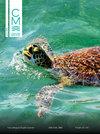Scenedesmus sp.和一个微藻联合体在非常规培养基中培养的代谢物的产生
IF 0.7
4区 生物学
Q4 MARINE & FRESHWATER BIOLOGY
引用次数: 0
摘要
采用1 mL·L-1 Bayfolan Forte肥料(BM)富集的处理废水(TWw)、(NH4)2HPO4富集的处理废水(PAM)、NH4HCO3富集的处理废水(BCAM)、养猪场废水(PEM)、养猪场废水消化液(PDM)和原液(Ww)培养微藻群落和Scenedesmus sp.。除TWw外,培养基中氮(N)含量调整为80 mg·L-1 N (NH4+-N和NO3——N)。低营养含量(BM和TWw)的非常规低成本培养基显示出足够的生物量和脂质产量。PEM是最有利的培养基,其生物量生产力最高(191.25±6.25 g·L-1·d-1),脂质生产力为36.75±9.90 mg·L-1·d-1。脂肪酸谱主要由C16和C18组成。PAM、PEM和PDM的饱和脂肪酸含量较高(60% ~ 69%),不饱和脂肪酸含量在31% ~ 38%之间。PEM和PDM对NH4+的去除率为100%;然而,由于挥发,有NH4+损失(如NH3)(46%)。非常规培养基,尤其是Ww,是培养微藻的一种选择。本文章由计算机程序翻译,如有差异,请以英文原文为准。
Production of metabolites from Scenedesmus sp. and a microalgal consortium cultured in unconventional media
Growth comparisons were made between a microalgal consortium and Scenedesmus sp. cultivated in treated wastewater (TWw) enriched with 1 mL·L–1 Bayfolan Forte fertilizer (BM), TWw enriched with (NH4)2HPO4 (PAM), TWw enriched with NH4HCO3 (BCAM), tap water with piggery wastewater (PEM), tap water with piggery wastewater digestate (PDM), and raw wastewater (Ww). Nitrogen (N) content in the media, except for TWw, was adjusted to 80 mg·L–1 N (NH4+-N and NO3–-N). Unconventional low-cost media with lower nutrient contents (BM and TWw) showed adequate productions of biomass and lipids. PEM was the most advantageous medium, showing the highest biomass productivity with the consortium (191.25 ± 6.25 g·L–1·d–1) and a lipid productivity of 36.75 ± 9.90 mg·L–1·d–1. The fatty acid profile was composed mainly of C16 and C18. PAM, PEM, and PDM showed a higher proportion of saturated fatty acids (60%–69%), whereas the composition of unsaturated fatty acids was in the range of 31% to 38%. In PEM and PDM the removal of NH4+ was 100%; however, there were NH4+ losses (as NH3) due to volatilization (46%). Unconventional media, especially Ww, are an option for growing microalgae.
求助全文
通过发布文献求助,成功后即可免费获取论文全文。
去求助
来源期刊

Ciencias Marinas
生物-海洋与淡水生物学
CiteScore
1.10
自引率
0.00%
发文量
9
审稿时长
>12 weeks
期刊介绍:
A bilingual open-access publication, Ciencias Marinas (CM) is an international peer-reviewed journal that contains original research findings in all areas of marine science. It is published quarterly by the Autonomous University of Baja California, Mexico, and all its contents are publicly available on our journal website. Though a limited number of copies are still printed, the journal is mainly distributed in its electronic format.
CM was conceived in 1973 as part of an academic project aimed to entice local researchers to publicly disclose their findings by adopting the culture of peer-review publishing. This academic project evolved into an international journal after accepting papers from researchers in the United States and, eventually, other parts of the world. Because of the diversity in authorship, CM issues were initially published in either Spanish or English, and occasionally in both languages. It was not until 1984 when CM included both language versions of all its contents, and it then became the fully bilingual journal it still is today. At CM we believe our inclusive format allows us not only to address a wider range of submissions from international authors but also to make published findings available to a wider international audience.
So whether you are looking for information on the redfish in Icelandic waters or the physical and biological properties of the Gulf of California, feel free to peruse CM contents. You may find them to provide source material for your research.
 求助内容:
求助内容: 应助结果提醒方式:
应助结果提醒方式:


